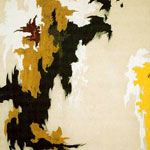Abstract Expressionism

This week, we pick up with the end of World War II. We start by looking at two very different images of soldiers. One is by George Grosz, a bleak image of a crippled WW I veteran, reduced to a beggar. The other, by Thomas Hart Benton, shows heroic young Americans heading off to Europe to fight. By the time World War II is over, neither of these methods of expression will seem adequate to the younger generation of artists.
Single events of this war were captured in so many detailed photographs that everyone understood the horror of what the world had gone through. But when it came to understanding the magnitude of the war–6 million civilians killed in the concentration camps, 180,000 killed by a single atomic blast–we humans are simply left contemplating our own inability to conceive of such large numbers.
One thing was for sure for the artist’s who became known as the Abstract Expressionists, a new artistic method was required to express this new understanding of the world and our place within it. Before the war, dozens of Europe’s best artists fled to America, creating an artistic atmosphere around New York perfect for the education of our young artists. We look at two artists: Arshile Gorky and Hans Hofmann, and their influence on the Abstract Expressionists.
We then systematically dissect works by the most prominent of these figures, looking for two things. First, what was their artistic intent, and means of production? Some of these artists were only interested in what paint on a canvass meant in and of itself. Some were interested in exploring issues of social justice, and some were convinced that with color alone, they could create a truely spiritual and transcendent experience.
Whether formalist or metaphysical in intent, all of these artists had an interest in the abstract gesture (except, as we learn, Ad Reinhardt, the exception who proves the rule). Our second desire in this class is to begin to examine this gesture as a signature mark of the artists. Our class is as much a field guide as it is history. And we must look at these works not just as individual pieces, but as parts of the artists’ oeuvre, or body of work, and learn to spot other works with these same signature gestures, signature colors, signature compositions.
After this class you should be able to
Define the following:
- Abstract Expressionism, and who fits into this category
- Color Field Painting, and who fits into this category
- Second-Genration Abstract Expressionism
- Metaphysical
- Transcendental
- “Push-pull” and who used this term
- “Soak and Stain” and who used this term
- “Zip” and who used this term
Recognize artwork by the following artists:
- Helen Frankenthaler
- Arshile Gorky
- Hans Hofmann
- Franz Kline
- Willem De Kooning
- Lee Krasner
- Morris Louis
- Robert Motherwell
- Barnett Newman
- Jackson Pollock
- Ad Reinhardt
- Marc Rothko
- Clyfford Still
Answer the following:
- What happened in the 1930s that caused painters to search for a new kind of abstraction?
- How does Sartre’s Existentialism fit these artists’ work?
- What made Jackson Pollock so appealing as an image of the new American painter?
- Explain Ad Reinhardt’s “Rules for the new academy”.
Links for further reading:
- MOMA’s “Abstract Expressionist New York” show, with tons of on-line interactive features
- Review of the MoMA show, and additional information on the Ab-Exers
- Ad Reinhardt’s 12 rules, posted on a webpage that breaks almost all of them!
- Gestalt Principals explained, with graphic examples
- Gestalt Principals explained, with fine art examples
- Basic pricipals of color theory explained
- Arshile Gorky Foundation
- Hans Hofmann Trust
- Pollock and Krasner House and Study Center
- Robert Motherwell, the Dedalus Foundation
- Full text of Lament for Ignacio Sanchez Mejias by Frederico Garcia Lorca
- Mark Rothko at the National Gallery of Art
- The Clyfford Still Museum under construction in Dever
- Clyfford Still, why you such a hater?
